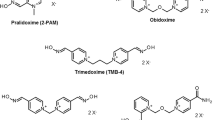Abstract
The hypothesis that acetylcholinesterase (AChE) inhibition is the mechanism of toxicity of organophosphorus (OP) compounds was examined by mathematically modeling the in vivo lethal effects of OP compounds and determining the amount of variation in OP toxicity that is explained by AChE inhibition. Mortality dose–response curves for several OP compounds (i.e., VX, soman, cyclosarin, sarin, tabun, diisopropylfluorophosphate and paraoxon) exhibited steep probit slopes (> 9.6) in guinea pigs. Steep probit slopes were also observed when the mortality dose–response curves for soman were examined in mice, rats, rabbits and non-human primates. The consistently steep probit slopes of the dose–response curves for highly toxic OP compounds suggested that these compounds have a single specific mechanism of toxicity regardless of the OP compound or the species in which it was tested. Regression analysis indicated that 93% of the 3,280-fold variation in the median lethal doses (i.e., LD50) of OP compounds in rats was explained by the variation in their in vitro rate constants for inhibition of AChE. Conversely, 91% of the 23-fold variation in the ability of the oximes pralidoxime and obidoxime to protect against the toxicity of OP compounds in guinea pigs was explained by the variation in the in vitro ability of oximes to reactivate OP-inhibited AChE. The best explanation for this variety of observations was that the primary mechanism of in vivo toxicity for highly toxic OP compounds is the inhibition of AChE, and the residual unexplained variation in OP toxicity that might be explained by other mechanisms represents < 10% of the total variation in OP toxicity.



Similar content being viewed by others
References
Casida JE, Quistad GB (2005) Serine hydrolase targets of organophosphorus toxicants. Chem Biol Interact 157–158:277–283
Dawson RM (1994) Review of oximes available for treatment of nerve agent poisoning. J Appl Toxicol 14:317–331
De Jong LPA, Benschop HP (1988) Biochemical and toxicological implications of chirality in anticholinesterase organophosphates. In: Ariens EJJ, Van Rensen JS, Welling W (eds) Stereoselectivity of pesticides: biological and chemical problems. Elsevier, Amsterdam, pp 109–149
Dirnhuber P, French MC, Green DM, Leadbeater L, Stratton JA (1979) The protection of primates against soman poisoning by pretreatement with pyridostigmine. J Pharm Pharmacol 31:295–299
Faustman EM, Omenn GS (2001) Risk assessment. In: Klassen CD (ed) Casarett and Doull’s Toxicology: the basic science of poisons. McGraw-Hill, New York, pp 83–104
Finney DJ (1971) Probit analysis. Cambridge University Press, Cambridge, pp 50–124
Fleisher JH, Harris LA, Miller GR, Thomas NC, Cliff WC (1970) Antagonism of sarin poisoning in rats and guinea pigs by atropine, oximes and mecamylamine. Toxicol Appl Pharmacol 16:40–47
Inns RH, Leadbeater L (1983) The efficacy of bispyridinium derivatives in the treatment of organophosphonate poisoning in the guinea pig. J Pharm Pharmacol 35:427–433
Karczmar AG (1970) History of the research with anticholinesterase agents. In: Karczmar AG (ed) Anticholinesterase agents, vol. 1, International encyclopedia of pharmacology and therapeutics, Sect 13, Pergamon, Oxford, pp 1–44
Lundy PM, Hansen AS, Hand BT, Boulet CA (1992) Comparison of several oximes against poisoning by soman, tabun and GF. Toxicology 72:99–105
Marrs TC (1993) Organophosphate poisoning. Pharmacol Ther 58: 51–66
Maxwell D (1992) The specificity of carboxylesterase protection against the toxicity of organophosphorus compounds. Toxicol Appl Pharmacol 114:306–312
Maxwell D, Brecht KM, Koplovitz I (1997) Characterization and treatment of the toxicity of O-isobutyl S-[2-(diethylamino)ethyl]methylphosphonothioate, a structural isomer of VX, in guinea pigs. J Am Coll Toxicol 15(2):S78–S88
Pope CN (1999) Organophosphorus pesticides: do they all have the same mechanism of toxicity? J Toxicol Environ Health B Crit Rev 2:161–181
Pope C, Liu J (2004) Non-cholinesterase actions of anticholinesterases. In: Flora SJS, Romano JA, Baskin SI, Sekhar K (eds) Pharmacological perspectives of toxic chemicals and their antidotes. Narosa Publishing, New Delhi, pp 215–239
Rai K, Van Ryzin J (1981) A generalized multihit dose–response model for low-dose extrapolation. Biometrics 37:341–352
Schuh RA, Lein PJ, Beckles RA, Jett DA (2002) Noncholinesterase mechanisms of chlorpyrifos neurotoxicity: altered phosphorylation of Ca2+/cAMP response element binding protein in cultured neurons. Toxicol Appl Pharmacol 182:176–185
Sultatos LG (1994) Mammalian toxicology of organophosphate pesticides. J Toxicol Environ Health 43:271–289
Szinicz L, Baskin SI (1999) Chemical and biological agents. In: Marquardt H, Schafer SG, McClellan RO, Welsch F (eds) Toxicology. Academic, San Diego, pp 851–877
Taylor P (2001) Anticholinesterase agents. In: Hardman JG, Limbird LE, Gilman AG (eds) Goodman and Gilmanȁ9s Pharmacological basis of therapeutics. McGraw-Hill, New York, pp 175–191
Worek F, Reiter G, Eyer P, Szinicz L (2002) Reactivation kinetics of acetylcholinesterase from different species inhibited by highly toxic organophosphates. Arch Toxicol 76:523–529
Author information
Authors and Affiliations
Corresponding author
Rights and permissions
About this article
Cite this article
Maxwell, D.M., Brecht, K.M., Koplovitz, I. et al. Acetylcholinesterase inhibition: does it explain the toxicity of organophosphorus compounds?. Arch Toxicol 80, 756–760 (2006). https://doi.org/10.1007/s00204-006-0120-2
Received:
Accepted:
Published:
Issue Date:
DOI: https://doi.org/10.1007/s00204-006-0120-2




